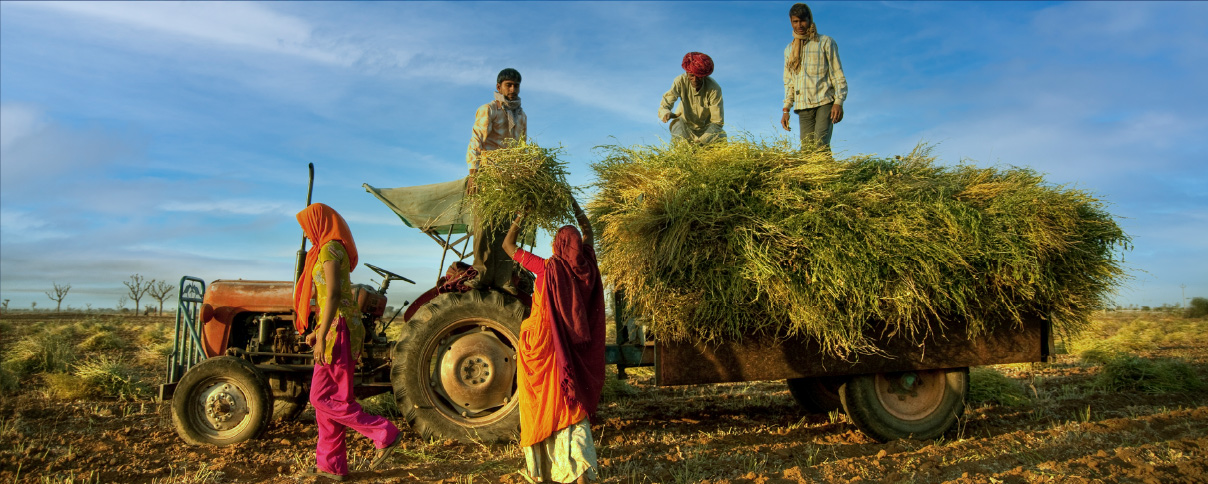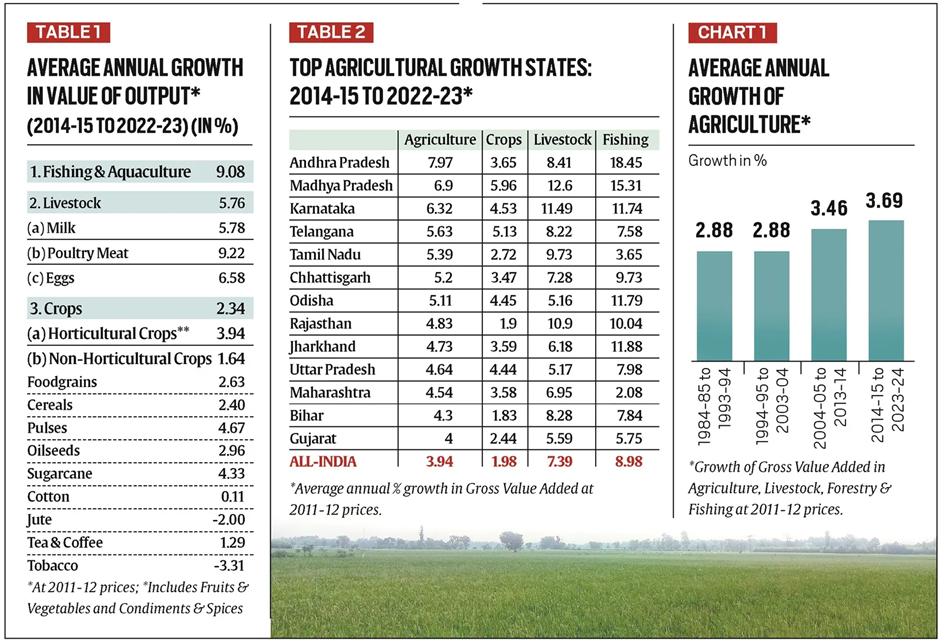Context:
The recent study by NITI Aayog regarding India’s agricultural sector growth offers a multifaceted view of the changes occurring in agriculture. While it emphasizes notable growth in specific sub-sectors, it also raises critical questions about the sustainability and inclusivity of this growth. This evaluation delves into both the achievements and challenges highlighted in the study, examining their implications for the future of Indian agriculture.
Achievements in Agricultural Growth
Overall Growth Trends
-
- The study indicates a significant improvement in the Gross Value Added (GVA) for agriculture, which rose from an average of 2.9% prior to 2004 to 3.7% during the NDA period. This growth challenges the prevailing notion of a sector in crisis and is particularly noteworthy in a country where agriculture serves as a primary livelihood for a substantial portion of the population.
- The study indicates a significant improvement in the Gross Value Added (GVA) for agriculture, which rose from an average of 2.9% prior to 2004 to 3.7% during the NDA period. This growth challenges the prevailing notion of a sector in crisis and is particularly noteworthy in a country where agriculture serves as a primary livelihood for a substantial portion of the population.
Sub-sector Performance
-
- Remarkable growth rates in livestock (5.8%), fisheries (9.2%), and horticulture (3.9%) reflect a diversification of the agricultural economy. Driven by changing consumer demands and supported by proactive government initiatives, these sectors have not only enhanced farmers' incomes but also generated employment opportunities and contributed to national economic growth.
- Remarkable growth rates in livestock (5.8%), fisheries (9.2%), and horticulture (3.9%) reflect a diversification of the agricultural economy. Driven by changing consumer demands and supported by proactive government initiatives, these sectors have not only enhanced farmers' incomes but also generated employment opportunities and contributed to national economic growth.
Increased Production
-
- The reported surge in cereal production from 185.2 million tonnes in 2004-05 to 303.6 million tonnes in 2022-23 suggests improvements in productivity, potentially due to advancements in agricultural technology, irrigation practices, and input usage. This increase aligns with broader national goals of achieving self-sufficiency in food production, particularly important for a growing population.
- The reported surge in cereal production from 185.2 million tonnes in 2004-05 to 303.6 million tonnes in 2022-23 suggests improvements in productivity, potentially due to advancements in agricultural technology, irrigation practices, and input usage. This increase aligns with broader national goals of achieving self-sufficiency in food production, particularly important for a growing population.
Challenges in Agricultural Growth
Stagnant Consumption vs. Production
-
- A critical concern raised by the study is the apparent discrepancy between reported production figures and household consumption of cereals. While production has significantly increased, stagnant consumption levels indicate that a large portion of the output may not be translating into actual food availability for consumers. This raises questions about the accuracy of data collection methods and the effectiveness of existing agricultural policies in addressing real food security challenges.
- A critical concern raised by the study is the apparent discrepancy between reported production figures and household consumption of cereals. While production has significantly increased, stagnant consumption levels indicate that a large portion of the output may not be translating into actual food availability for consumers. This raises questions about the accuracy of data collection methods and the effectiveness of existing agricultural policies in addressing real food security challenges.
Disparities among Sub-sectors
-
- The slower growth rate of traditional crop agriculture (2.3%) compared to livestock and fisheries suggests a potential neglect of this vital segment. Regions known for their agricultural output, such as Punjab and Haryana, report growth rates between 2% and 3.4%. This stagnation poses risks to the livelihoods of farmers reliant on traditional crops, who may not benefit from the broader advancements observed in other sub-sectors.
- The slower growth rate of traditional crop agriculture (2.3%) compared to livestock and fisheries suggests a potential neglect of this vital segment. Regions known for their agricultural output, such as Punjab and Haryana, report growth rates between 2% and 3.4%. This stagnation poses risks to the livelihoods of farmers reliant on traditional crops, who may not benefit from the broader advancements observed in other sub-sectors.
Unequal Distribution of Benefits
-
- The survey cited in the study reveals that only 53% of farmers earn income from livestock, and just 6.5% engage in horticulture. This indicates that the benefits of agricultural growth are not universally accessible, with many farmers still dependent on traditional crops, which have not received the same levels of technological support or market access, exacerbating inequalities within the agricultural community.
- The survey cited in the study reveals that only 53% of farmers earn income from livestock, and just 6.5% engage in horticulture. This indicates that the benefits of agricultural growth are not universally accessible, with many farmers still dependent on traditional crops, which have not received the same levels of technological support or market access, exacerbating inequalities within the agricultural community.
Market Dynamics and Vulnerabilities
-
- While the shift towards higher-value crops and livestock is a positive development, it also makes farmers vulnerable to market fluctuations. Reliance on a few high-demand products can increase risks, particularly in the face of changing consumer preferences and global market dynamics. Without adequate risk management strategies, farmers may find themselves exposed to sudden price drops or shifts in demand.
- While the shift towards higher-value crops and livestock is a positive development, it also makes farmers vulnerable to market fluctuations. Reliance on a few high-demand products can increase risks, particularly in the face of changing consumer preferences and global market dynamics. Without adequate risk management strategies, farmers may find themselves exposed to sudden price drops or shifts in demand.
|
Government Schemes Propelling Growth in the Agriculture Sector Several government schemes have been instrumental in propelling growth in agriculture: Pradhan Mantri Fasal Bima Yojana (PMFBY) Launched: 2016 Objective: Provides affordable crop insurance covering pre-sowing to post-harvest risks. Impact: Protects farmers against losses from natural disasters, stabilizing income and encouraging investment in agricultural activities. Pradhan Mantri Kisan Samman Nidhi (PM-KISAN) Introduced: February 24, 2019 Objective: Provides ₹6,000 per year to landholding farmers. Impact: Helps farmers manage expenses, improving productivity and reducing reliance on informal credit. Modified Interest Subvention Scheme (MISS) Objective: Offers concessional short-term agricultural loans at an interest rate of 7% per annum. Impact: Reduces borrowing costs, encouraging investments in inputs, technology, and sustainable practices. Agriculture Infrastructure Fund (AIF) Launched: 2020 Objective: Provides medium to long-term debt financing for agricultural infrastructure projects. Impact: Supports investments in post-harvest infrastructure, reducing wastage and increasing value. National Programme for Dairy Development Objective: Aims to increase milk production and productivity. Impact: Enhances the livelihoods of dairy farmers through better breeding practices and improved processing facilities. National Beekeeping & Honey Mission (NBHM) Launched: 2020 Objective: Promotes scientific beekeeping and aims to increase honey production. Impact: Supports crop pollination and enhances the income of farmers engaged in beekeeping. Micro Irrigation Fund (MIF) Initial Corpus: ₹5,000 crore Objective: Facilitates micro-irrigation in horticulture and other crops. Impact: Promotes efficient water use, leading to higher yields and better-quality produce. Paramparagat Krishi Vikas Yojana (PKVY) Objective: Promotes organic farming practices and increases soil fertility. Impact: Encourages sustainable practices that enhance soil health and reduce chemical usage. Pradhan Mantri Matsya Sampada Yojana (PMMSY) Launched: 2020 Objective: Enhances fisheries production and productivity. Impact: Supports aquaculture practices and market access for fish farmers. |
Policy Implications and Recommendations:
- The findings of the NITI Aayog study suggest several important policy implications. First, there is a clear need for targeted interventions that support crop diversification, particularly for farmers engaged in traditional agriculture. Policies should prioritize access to technology, training, and market linkages to enable these farmers to transition to higher-value production systems.
- Second, addressing disparities in income generation across different agricultural activities is crucial. This involves enhancing support systems for farmers reliant on traditional crops, including investment in research and development for crop varieties and improved irrigation facilities.
- Moreover, improving data collection and transparency in agricultural statistics is essential. Accurate data on production, consumption, and market dynamics can inform policymakers and help them craft more effective interventions. Enhanced monitoring and evaluation frameworks can also aid in understanding the true impact of agricultural policies on various farmer groups.
Conclusion:
NITI Aayog study provides compelling evidence of growth in India’s agricultural sector under the NDA government, it also highlights significant challenges that need to be addressed. The shift towards livestock, horticulture, and fisheries reflects a dynamic agricultural landscape but raises concerns about the inclusivity of this growth. Policymakers must focus on ensuring that all farmers can benefit from advancements in agriculture, particularly those still reliant on traditional crops. By doing so, India can work towards a more equitable and sustainable agricultural future that supports the livelihoods of its diverse farming community.
|
Probable questions for UPSC Mains exam: Critically evaluate the NITI Aayog's findings on India's agricultural growth, considering both the achievements and challenges highlighted in the study. |
Source-Indian Express, Pib









